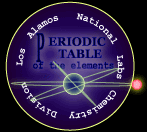

| Atomic Number: | 55 |
Atomic Radius: | 265.4 pm | ||
| Atomic Symbol: | Cs |
Melting Point: | 28.5 �C | ||
| Atomic Weight: | 132.9054 | Boiling Point: | 671 �C | ||
| Electron Configuration: | [Xe]6s1 |
Oxidation States: | 1 |
(L. caesius: sky blue) Cesium was discovered spectroscopically in 1860 by Bunsen and Kirchhoff in mineral water from Durkheim.
Cesium, an alkali metal, occurs in lepidolite, pollucte (a hydrated silicate of aluminum and cesium), and in other sources. One of the world's richest sources of cesium is located at Bernic Lake, Manitoba. The deposits are estimated to contain 300,000 tons of pollucite, averaging 20% cesium.
It can be isolated by elecytrolysis of the fused cyanide and by a number of other methods. Very pure, gas-free cesium can be prepared by thermal decomposition of cesium azide.
The metal is characterized by a spectrum containing two bright lines in the blue along with several others in the red, yellow, and green wavelengths. It is silvery white, soft, and ductile. It is the most electropositive and most alkaline element.
Cesium, gallium, and mercury are the only three metals that are liquid at room temperature. Cesium reacts explosively with cold water, and reacts with ice at temperatures above -116C. Cesium hydroxide, the strongest base known, attacks glass.
Because of it has great affinity for oxygen, the metal is used as a "getter" in electron tubes. It is also used in photoelectric cells, as well as a catalyst in the hydrogenation of certain organic compounds.
The metal has recently found application in ion propulsion systems. Cesium is used in atomic clocks, which are accurate to 5 s in 300 years. Its chief compounds are the chloride and the nitrate.
Cesium has more isotopes than any element--32--with masses ranging from 114 to 145.
The present price of cesium is about $30/g.
Title Picture: puddle of cesium: the pure solid melts at room temperature

Sources: CRC Handbook of Chemistry and Physics and the American Chemical Society.
Last Updated: 12/15/2003,� Chemistry Operations
Operated by the University
of California for the US Department
of Energy
|
Help
| Copyright � UC 2003 | Disclaimer